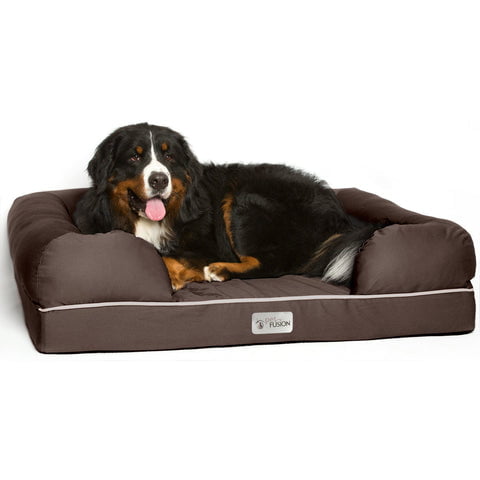What happens if my dog eats bed stuffing?
If you have a dog at home that you suspect may have eaten bed stuffing, the next question that you may want to ask is, “What happens if my dog eats bed stuffing?” Is eating bed stuff harmful to the dog? How do I stop my dog from eating bed stuffing? The answers to the above questions will be provided in this article.
For dog owners, you are probably well aware that your dog has a tendency to chew on anything they can get their paws on. While some dogs might stick to toys and bones, others may be more prone to ripping apart their bedding and furniture. In some cases, this can result in them ingesting the stuffing from their bed, and this can lead to a range of potential health issues.
Recommended articles:
- How to wash a large dog bed with stuffing
- Top 5 Best Dog Beds for Shih Tzu to Keep Them Comfy and Cozy
- How to disinfect blankets without washing
What happens if my dog eats bed stuffing?
Coming to this question, there are so many potential problems that could arise if your dog eats bed stuffing. Although your dog wouldn’t die from ingesting a small amount of stuffing, it can easily pass it out through its digestive system without hassle. However, if you ate a large quantity of bed stuffing, this could cause blockages in your digestive tract, which could be potentially life-threatening.
What is bed stuffing?
Bed stuffing, also known as cushion stuffing, is the material used to fill dog beds, pillows, and other soft furnishings. It is typically made from a variety of materials, including foam, polyester fiberfill, feathers, and even natural materials like wool or cotton.
The type of stuffing used can vary depending on the manufacturer and the intended use of the bed. Some dog beds may contain a mix of different types of stuffing to provide both support and comfort. So, when it comes to choosing a dog bed, it’s important to consider the type of stuffing used, as some materials can be more durable, hypoallergenic, or resistant to chewing than others.
Is polyester fill toxic?
Polyester fill is generally considered safe for dogs. It is a commonly used material for stuffing dog beds and toys and is known for its hypoallergenic and non-toxic properties. In most cases, dogs can safely chew on and ingest small amounts of polyester fill without experiencing any adverse health effects.
However, it’s important to note that the safety of polyester fill can depend on the specific product and manufacturing process. Some types of polyester fill may be treated with chemicals that could potentially be harmful to dogs if ingested in large quantities. Additionally, if a dog ingests a large amount of polyester fill, it could cause blockages in their digestive system, which could be potentially life-threatening.
So what happens if my dog eats bed stuffing?
When dogs eat stuffing, they can potentially encounter several problems, including:
Blockages
One of the most serious problems that dogs can encounter when they eat stuffing is the formation of blockages in their digestive system. When a dog ingests stuffing, it can clump together in their stomach or intestines and create a blockage, which can be potentially life-threatening.
Choking
Dogs that eat stuffing can also be at risk of choking. If a dog chews off a piece of stuffing that is too large to swallow, it can get lodged in their throat and block their airway, which can be fatal if not treated quickly.
Gastrointestinal upset
Eating stuffing can also cause dogs to experience gastrointestinal upset, such as vomiting, diarrhea, and abdominal pain. This is because the stuffing may not be easily digestible and can irritate the lining of the dog’s stomach and intestines.
Allergic reactions
In some cases, dogs may be allergic to the materials used in the stuffing, such as foam or polyester fibers. This can cause symptoms like itching, hives, and difficulty breathing.
Ingestion of toxic chemicals
Some types of stuffing may be treated with chemicals that could be toxic to dogs if ingested in large quantities. These chemicals can include flame retardants, which have been linked to health issues like cancer and developmental delays.
Read also>> Why does my puppy keep peeing in his bed?
What happens if my dog eats couch stuffing?
Just as there are several risks involved when a dog eats bed stuffing, eating couch stuffing poses the same amount of risks. If your dog eats couch stuffing, they may experience serious health problems like blockages, choking, stomach upset, allergic reactions, and ingestion of toxic chemicals.
What happens if my dog eats toy stuffing?
If your dog eats toy stuffing, they may experience gastrointestinal upset, such as vomiting and diarrhea, just as when they ate bed stuffing or couch stuffing. In some cases, they may also be at risk of blockages or choking, depending on the size and amount of stuffing ingested.
What should I do if my dog eats stuffing?
If your dog eats stuffing, here are the steps you should take:
- Don’t panic: It’s important to be calm and try not to panic. While eating stuffing can potentially be dangerous for dogs, the severity of the situation will depend on the size and amount of stuffing ingested, as well as the type of stuffing.
- Keep a close eye on your dog: Keep an eye on your dog and observe their behavior for any signs of illness or distress. This may include vomiting, diarrhea, lethargy, a loss of appetite, or difficulty breathing.
- Check for blockages or choking hazards: If you suspect that your dog has ingested a large amount of stuffing or is experiencing difficulty breathing, check their mouth and throat for any signs of blockages or choking hazards. If you see anything lodged in their throat or airway, it’s important to seek emergency veterinary care immediately.
- Call your veterinarian: Contact your veterinarian and let them know that your dog has ingested stuffing. They can provide guidance on what to do next and may recommend bringing your dog in for an examination.
- Follow your veterinarian’s instructions: If your veterinarian recommends bringing your dog in for an examination or treatment, follow their instructions carefully. Depending on the severity of the situation, they may recommend monitoring your dog at home, administering medications, or even performing surgery to remove any blockages.


